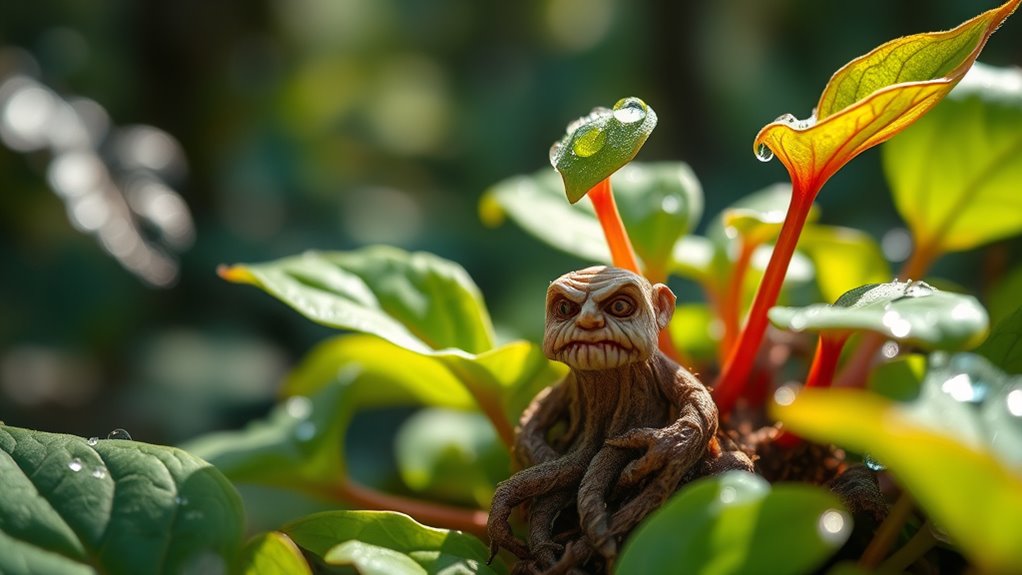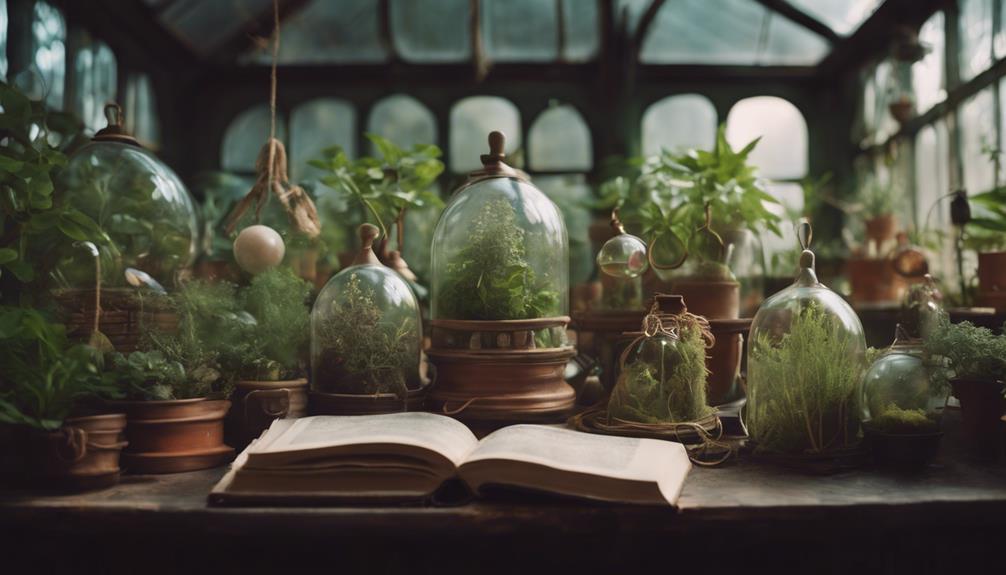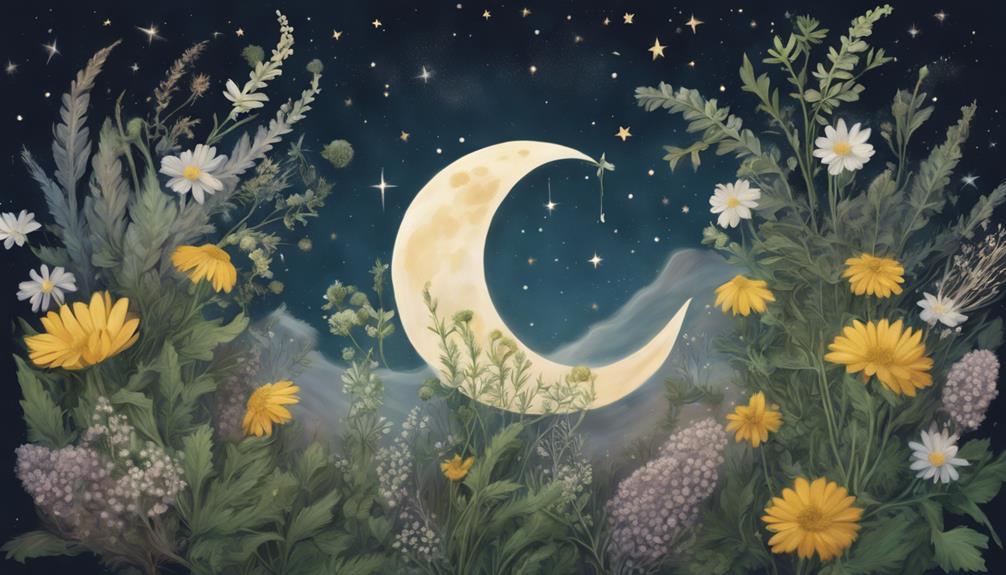Mandrakes, often associated with magic in folklore and mythology, are real plants with a rich history in traditional medicine and symbolism. They have a distinctive, human-like root that inspired legends of danger and protection. While fictional versions, like those in Harry Potter, emphasize their magical properties, actual mandrakes are toxic and require careful handling. Exploring their true botanical traits and cultural significance can reveal the fascinating blend of myth and science behind this legendary plant. Keep exploring to uncover more intriguing details.
Key Takeaways
- Mandrakes are perennial herbs with a tuberous root resembling a human figure, historically linked to magic and protection.
- Mythology portrays mandrakes as scream-capable plants that can cause madness or death when uprooted.
- In reality, the root’s shape and folklore contributed to their legendary status, but scientifically, they are tuberous roots, not humanoid.
- Scientific studies have clarified their botanical traits, revealing connections to nightshade plants and dispelling myths of magical humanoid features.
- Historically used in traditional medicine for pain and fertility, mandrakes are toxic and require careful handling, contrasting their mystical reputation.
Origins and Cultural Significance of Mandrakes
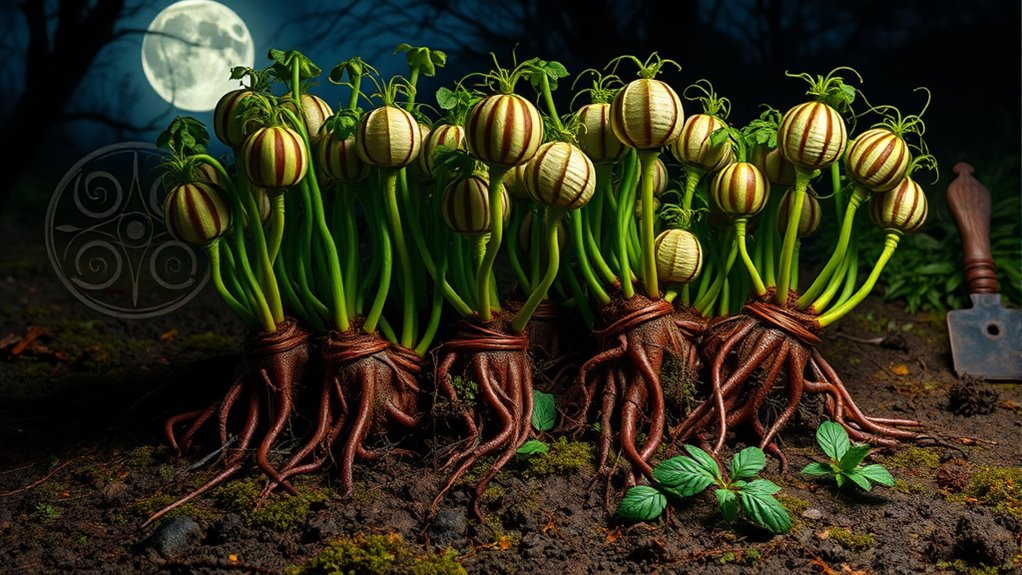
The origins of mandrakes trace back thousands of years to ancient civilizations that regarded them as powerful and mysterious plants. These cultures believed mandrakes held significant cultural symbolism, often associating them with magic, fertility, and protection. People used medicinal preparations derived from mandrake roots in traditional healing practices, trusting in their perceived curative powers. Its striking appearance and rumored properties made it a focal point in rituals and folklore, symbolizing both life and danger. You might find that ancient texts and myths depict mandrakes as enchanted plants with potent effects, reinforcing their mystical status. Additionally, the use of medicinal preparations derived from mandrake roots connects to traditional healing practices, which incorporated various plants believed to possess healing properties. This historical context highlights how deeply intertwined mandrakes are with cultural symbolism and medicinal lore across different societies. By understanding this history, you see how mandrakes became ingrained in cultural consciousness, blending medicinal use with symbolic meaning that persists through centuries.
Botanical Characteristics of the Mandrake Plant

Mandrake plants are perennial herbs known for their distinctive appearance and complex root system. Their plant morphology features a thick, fleshy, forked root that resembles a human figure, which contributes to their mythic reputation. The plant typically has broad, lobed leaves that form a rosette at the base, and tall flowering stalks emerge from the center, bearing bell-shaped flowers. The root structure is especially notable; it’s often humanoid in shape, with multiple branches that can resemble limbs or a face. This unique root form is what fuels many of the legends surrounding mandrakes. Interestingly, the botanical characteristics of the mandrake include its aromatic properties and its ability to contain alkaloids, which historically contributed to its mystique and supposed magical properties. Overall, the botanical characteristics combine to give the mandrake its striking, almost uncanny appearance, making it easily distinguishable from other herbs.
Historical Uses and Beliefs Surrounding Mandrakes
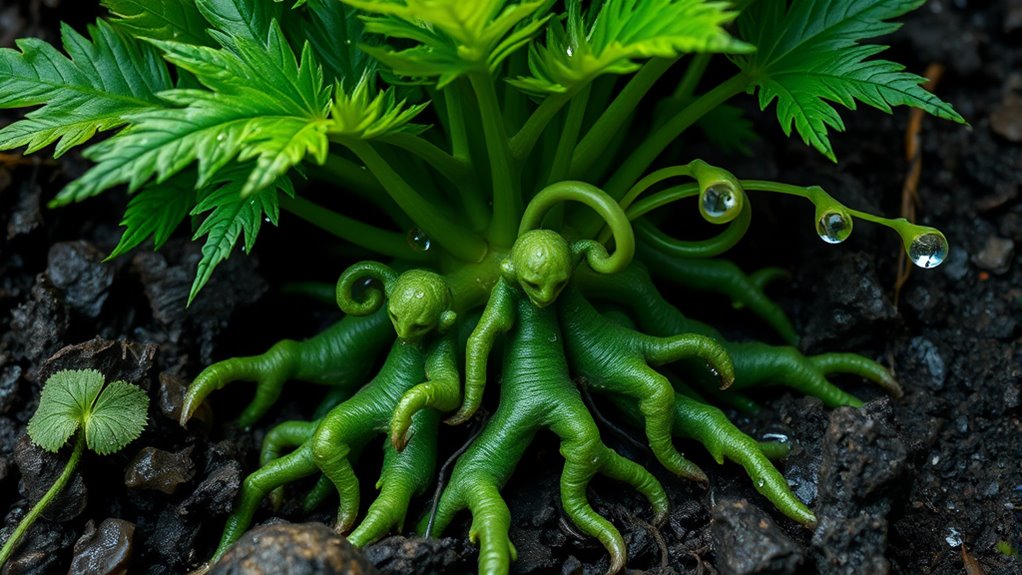
Throughout history, mandrakes have been shrouded in mysticism and superstition, often believed to possess powerful magical properties. Mandrake folklore highlights its association with fertility, protection, and healing. Many believed the plant’s root, resembling a human figure, held spiritual significance and could influence life and death. People used mandrakes in rituals, believing they could ward off evil or bring good luck. Its botanical symbolism reflects themes of life force and transformation. Some thought extracting the root would cause deadly screams, adding to its dangerous allure. The plant’s mythical reputation contributed to its fearsome reputation and the caution exercised when handling it. In addition, the plant’s botanical symbolism has inspired various cultural representations of life and rebirth. Interestingly, the water-related symbolism associated with plants like mandrakes emphasizes their connection to life and renewal in many traditions. Recent studies on plant mythology reveal how these beliefs influence modern herbal practices and cultural narratives. Below is a table summarizing key beliefs:
| Belief/Use | Cultural Significance |
|---|---|
| Fertility aid | Enhances reproductive power |
| Protection | Ward off evil spirits |
| Healing | Cures ailments |
| Dangerous screams | Fatal myth |
| Spiritual symbolism | Human-like roots |
Mythical and Folklore Connections to Mandrakes
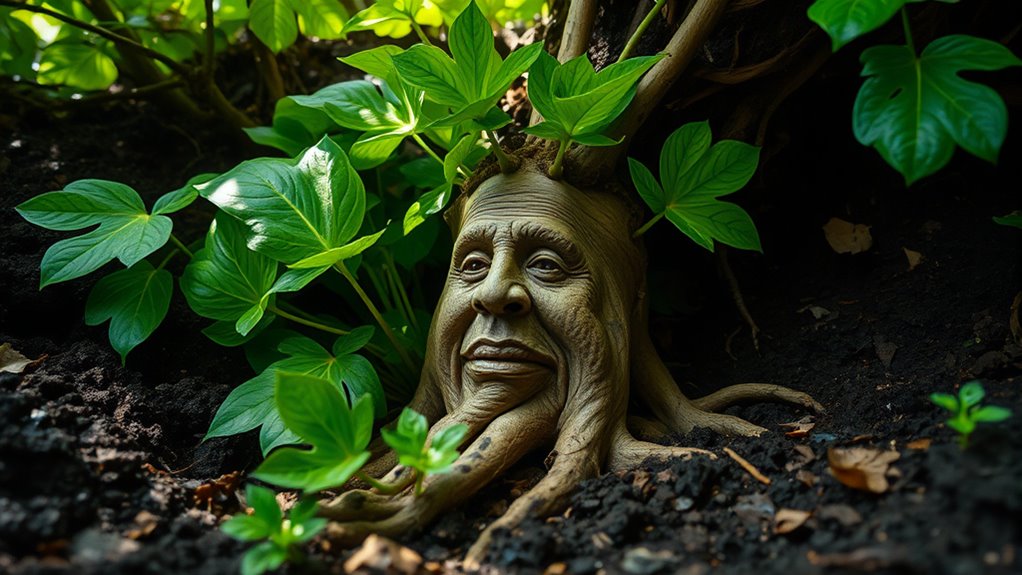
Ancient legends and folk tales have woven the mandrake’s image into a tapestry of mythical powers and supernatural mysteries. In mandrake folklore, this plant symbolizes both protection and danger, often linked to its eerie human-like shape and potent roots. Its legend warns of deadly consequences if mishandled, fueling fears and fascination. You might feel a mix of awe and trepidation as you imagine its whispered powers. The plant’s symbolism extends beyond fear, representing fertility, magic, and life’s mysteries. Its mythic reputation endures through stories of its scream, which could kill or cause madness. These stories evoke a sense of wonder and caution, reminding us of the plant’s mystical status in various cultures and its enduring role in humanity’s collective imagination.
The Role of Mandrakes in Traditional Medicine
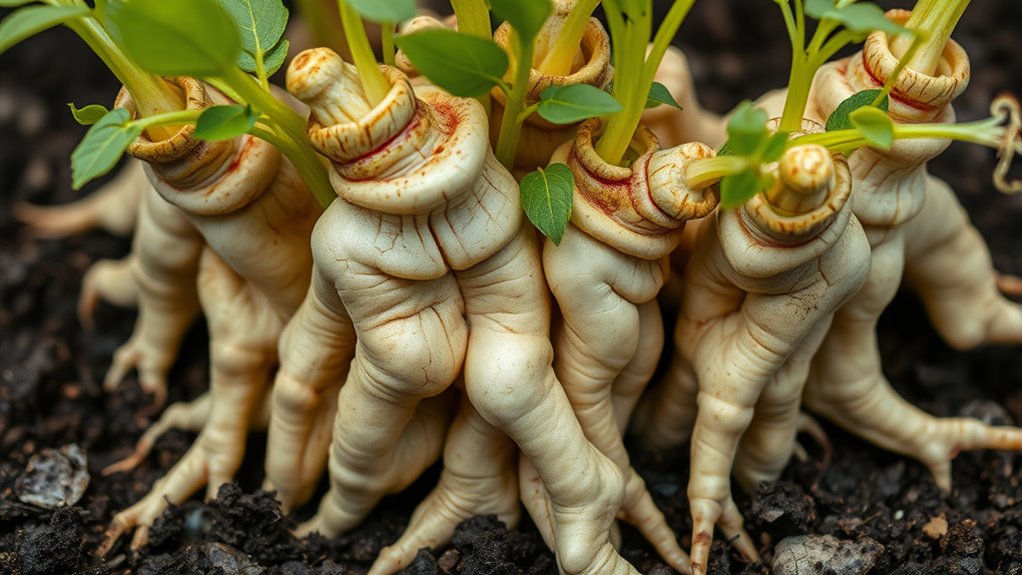
Throughout history, mandrakes have been used in traditional medicine for various treatments, but their applications come with significant risks due to toxicity. You should understand both their ancient medicinal uses and the precautions needed to avoid harm. Today, herbalists explore modern applications, balancing traditional knowledge with safety considerations.
Historical Medicinal Uses
Have you ever wondered how mandrakes found their place in traditional medicine? Throughout medicinal history, this mysterious root was believed to possess powerful healing properties, often intertwined with cultural symbolism. People used mandrakes for:
- Easing pain and reducing inflammation
- Treating mental ailments like anxiety and depression
- Acting as an anesthetic during surgeries
- Offering protection against evil spirits
These uses reflect their significance beyond mere botany, embodying hope and fear in many cultures. The mandrake’s human-like shape fueled mystical beliefs, making it a symbol of life, death, and rebirth. While these practices reveal the plant’s revered role in ancient healing traditions, they also highlight how deeply rooted it was in cultural mythology, shaping perceptions that persist even today. Additionally, the historical medicinal uses of mandrakes demonstrate their significance in traditional medicine, where they were once valued for their supposed healing and protective properties. The complex relationship between botanical symbolism and medicinal practices underscores the enduring mystique surrounding the mandrake. Moreover, early pharmacological experiments used mandrake extracts to explore plant-based remedies, contributing to the development of herbal medicine.
Toxicity and Precautions
While mandrakes held significant medicinal value in traditional practices, they are inherently toxic and require careful handling. The plant’s poisonous effects can cause severe symptoms like nausea, hallucinations, and even respiratory distress if misused. Because of this, strict safety precautions are essential when working with mandrakes. Always wear gloves and protective clothing to prevent skin contact, and avoid inhaling any fumes or dust. Never ingest parts of the plant unless under expert supervision, as even small doses can be dangerous. Proper storage in labeled, secure containers is vital to prevent accidental poisoning. Remember, despite their historical use, mandrakes are not safe for casual use today. Respect their potency and handle them with the utmost caution to avoid harmful consequences.
Modern Herbal Applications
Did you know that despite its toxicity, mandrake has played a significant role in traditional medicine systems? Its medicinal properties were valued for centuries, often used to treat pain, insomnia, and even fertility issues. However, understanding its horticultural cultivation was vital to harnessing its benefits safely. Cultivating mandrake with specialized knowledge helps mitigate its risks while utilizing its traditional applications. Proper cultivation practices, including toxicity management, are essential for safe use. Additionally, the plant’s distinctive root and its cultural significance have contributed to its legendary reputation throughout history. Recognizing the plant’s botanical characteristics aids in its safe handling and effective use. Developing cultivation techniques that prioritize safety can further support responsible use of this historically important plant. Dog names such as those inspired by its mystical qualities have even been adopted for pets and plants alike.
Comparing Fictional and Real Mandrakes in Popular Culture
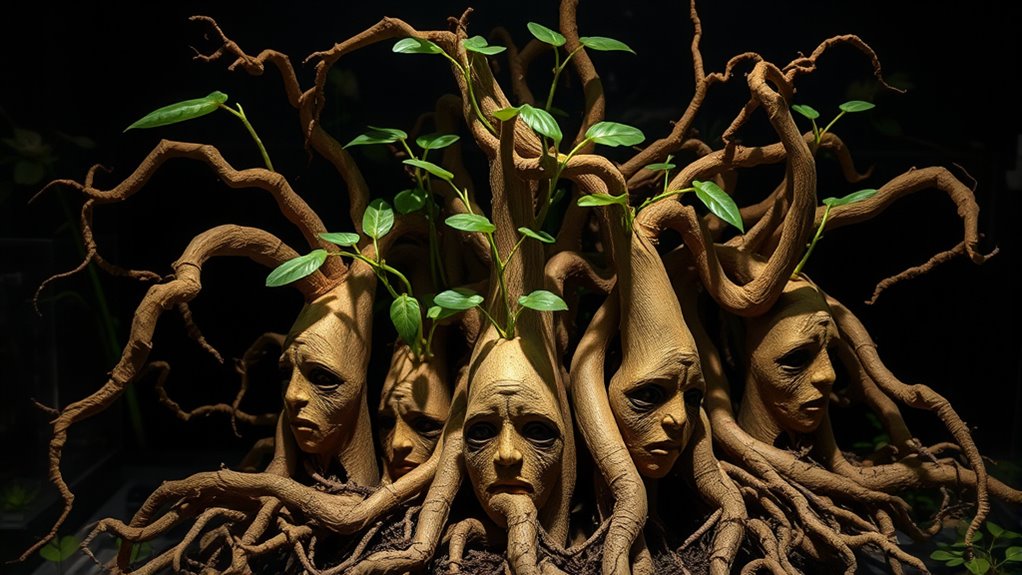
In popular culture, the depiction of mandrakes often blurs the line between myth and reality, creating fascinating contrasts for enthusiasts and skeptics alike. Fictional adaptations, like Harry Potter, emphasize their magical qualities—screaming loudly when uprooted and possessing potent curses—highlighting their cultural symbolism as deadly or enchanted plants. In contrast, real mandrakes are rooted in herbal tradition, with mythic roots that symbolize protection and mysticism. These differences show how fiction amplifies their mysterious allure, while reality grounds them in botanical history. Consider the following comparison:
| Aspect | Fictional Mandrakes | Real Mandrakes |
|---|---|---|
| Cultural Symbolism | Enchanted, cursed, or magical plant | Mystical, protective herb |
| Appearance | Human-like root shape | Similar root shape, less dramatic |
| Uses | Potion ingredients, magical rituals | Traditional herbal remedies |
| Popularity | Featured in fantasy stories and films | Known in herbal medicine |
Additionally, real mandrakes have been used historically in various herbal practices that emphasize their mystical significance. Some herbal traditions attribute protective properties to mandrakes, linking them to mystical symbolism and folklore. Scientific studies have also analyzed their chemical components, which contribute to their herbal efficacy and legendary reputation. This dual perspective illustrates how their representation blends cultural myth with botanical reality, enriching their historical importance.
Modern Scientific Perspectives on the Mandrake Plant
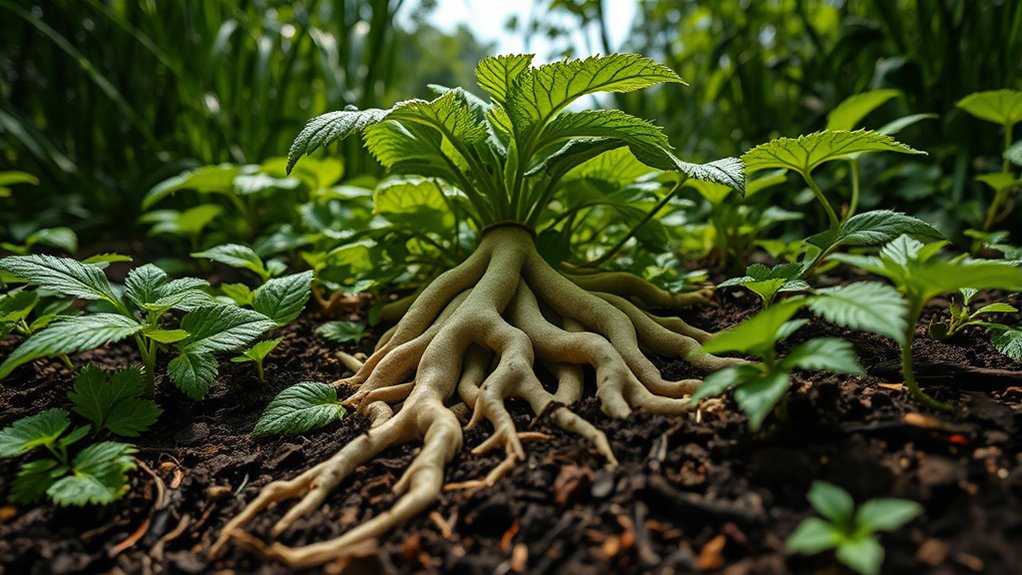
Modern scientific research has provided valuable insights into the mandrake plant’s biological characteristics, dispelling many myths while uncovering its true botanical nature. Through advances in plant propagation and genetic research, scientists now understand its unique root system and growth patterns. You might find it fascinating that, despite its legendary reputation, the mandrake’s true form is a complex, tuberous root rather than a humanoid figure. Furthermore, understanding headphone compatibility with various devices can enhance the research process by ensuring accurate data collection and analysis. Imagine discovering:
Modern science reveals the mandrake as a tuberous root, not the legendary humanoid figure of myth.
- The potential to cultivate mandrakes sustainably through careful plant propagation techniques
- How genetic research reveals its evolutionary links to other nightshade plants
- The possibility of accessing medicinal properties hidden within its DNA
- How modern science demystifies ancient fears, grounding the myth in reality
Frequently Asked Questions
Are Mandrakes Legally Protected or Endangered in Any Regions?
You’ll find that mandrakes are generally not legally protected or endangered in most regions, but their legal status varies. In some areas, conservation efforts focus on preserving native plants, which may include mandrakes if they’re rare or threatened. It’s essential to check local regulations because some countries or regions may have specific laws safeguarding wild mandrakes, especially if they’re part of traditional medicine or rare botanical species.
Can Mandrake Plants Be Cultivated Safely at Home?
You can cultivate mandrake plants at home, but you should prioritize safety precautions. Use gloves and eye protection when handling the plant, as some parts may be toxic. Make sure to grow it in a secure, well-ventilated area away from children and pets. Research local regulations, as mandrakes may be protected or restricted in certain regions. With proper care and precautions, you can enjoy growing this fascinating plant safely.
What Are the Potential Health Risks of Handling Mandrake Root?
Handling mandrake root poses significant health risks due to its plant toxicity. You should exercise strict handling precautions, as contact can cause skin irritation, and accidental ingestion may lead to severe poisoning or hallucinations. Always wear gloves, avoid inhaling fumes, and wash your hands thoroughly afterward. Keep mandrake out of reach of children and pets to prevent accidental exposure, and consult a professional before working with this potent plant.
How Do Mandrakes Compare to Other Toxic or Hallucinogenic Plants?
You’ll find mandrakes more toxic than many common plants, with severe symptoms if ingested or mishandled. Compared to other toxic or hallucinogenic plants, mandrakes have a unique combination of potent alkaloids that can cause intense hallucinations and dangerous physiological effects. While some plants like belladonna or datura also induce hallucinations, mandrakes are particularly hazardous due to their high toxicity and the risk of violent reactions if not handled carefully.
Are There Ongoing Scientific Studies on Mandrake’s Medicinal Properties?
You’ll be interested to know that botanical research and pharmacological studies on mandrake are ongoing. Despite its long history in traditional medicine, only about 20% of its compounds have been fully explored for medicinal use. Scientists are actively investigating its alkaloids for potential pain relief and sedative effects. This research could open new medical applications, making mandrake a promising focus in modern pharmacology.
Conclusion
As you explore the mandrake’s rich history, you see it as a bridge between myth and reality, like a thread weaving through centuries of belief and science. Its roots dig deep into cultural soil, anchoring legends in the world of botany and medicine. Though fiction paints it as a magical, sometimes dangerous plant, real-life mandrakes remind you that nature’s mysteries are often rooted in truth, waiting for curious minds to uncover their secrets and give them new life.

